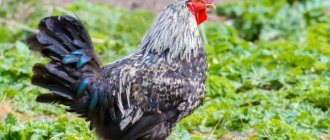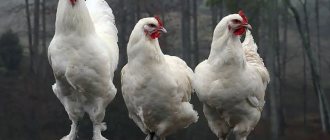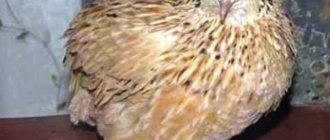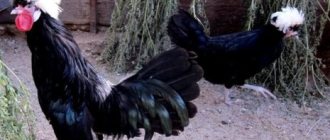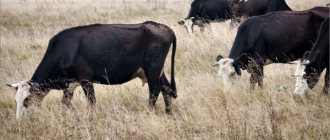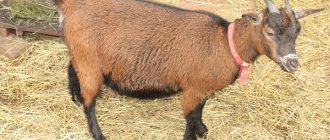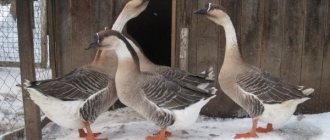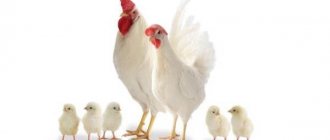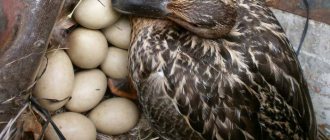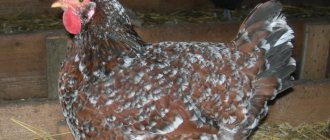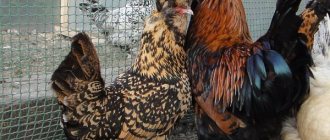If you enter the query “turkey-chicken hybrid” into a search service, the search engine will probably return photos of chickens with a bare red neck, similar to the neck of an angry turkey. Not actually a hybrid in the photo. This is a bare-necked breed of chicken that appeared as a result of mutation.
The breed is believed to originate from Transylvania. But this opinion is controversial, since they have only just begun to spread across Europe from Romania and Hungary. In these countries they were called Semigrad Golosheks. Spain, more precisely, Andalusia, also claims to be the author of the breed. Bare-necked Transylvanian (Spanish) chickens are especially common in Germany and France. France has already developed its own breed, which is not related to the Transylvanian bare-necked chickens. However, holo-necks are very rare in England and unknown in the USA.
Interesting! One of the European names for bare-necked chickens is “Turken”.
The name is formed from the traditional compilation of the names of the parent species for hybrids. It took root due to confusion when genetic research was not yet developed and it was believed that the bare-necked chicken was a hybrid of a turkey and a chicken. In fact, the North American turkey does not interbreed with any species of pheasant, and the naked-necked fowl is a purebred bird belonging to the banker fowl species.
Although the breed is not found in the United States, the American Poultry Association recognized it in 1965. The bare-necked chicken was first shown in Great Britain in 1920. In the CIS, the Transylvanian (or Spanish) version of bare-necked chickens is bred.
Interesting! Bare-necked chickens also exist among bantams, but they are not a dwarf form of the Transylvanian (Spanish).
The photo shows bare-necked roosters. On the left is a Spanish bareneck, on the right is a French nakedneck.
Compared to the French version, Spanish chickens more closely resemble an angry turkey.
A bit of origin history
So, where does the unusual bare-necked chicken come from? In fact, several breeds of chicken fit this description. But the most popular among the bare-necked is the Spanish flu. Spain is the birthplace of this breed. However, bare-necked chickens came to Russia from Romania and Hungary. Therefore, at first in our country these chickens were called Transylvanian.
What influences the plumage features of barenecks? It's all due to a special gene that is passed on from generation to generation. Already at the embryonic stage, chickens develop uneven plumage. There are no feather follicles in the neck area, which means birds will never grow feathers in this area. By the way, the bare-necked gene is dominant: when crossed with other breeds, geneticists always get chickens without feathers on the neck/
The history of the appearance of the bare-necked chicken breed
To date, there is no consensus on the country of origin of the bare-necked chicken breed. Experts are considering several versions. Some believe that bare-necked chickens come from medieval Transylvania (the territory of modern Romania). This is where their names “Transylvanian” and “Semigrad” came from.
According to another version, this breed has only become widespread in Romania, and Andalusia, an autonomous community of Spain, should be considered the true homeland of barenecks. That's why they are also called Spanish flues.
The first mention of birds of this unusual breed was made in 1875 in Austria. In the CIS countries, Semigrad chickens gained fame in 1930. Currently, naked necks are especially popular in Germany and France. In the UK, the naked breed of chickens is quite rare, and in the USA it is completely absent.
From a genetic point of view, there is no subject for debate. It has been scientifically proven that this is a purebred breed that belongs to the Bank jungle fowl species.
Appearance
Representatives of the Spanish chicken breed have a unique plumage. On the body it does not differ from that which other birds have, but on the neck it is completely absent. This feature gave rise to the name bare-necked chicken breed. The bird's bare neck has an intense red color, which is only slightly inferior to the beard and crest.
The bare neck is a genetic feature that is formed during the intraovarian development of the bird. The chickens, having hatched, already have a sign of the breed and there is no fluff on their necks. On the head, bare-necked chickens have an island of feathers that looks like a hairstyle. On the chest side at the base of the neck, birds have lush downy plumage, similar to a frill.
The bird's earrings are bright, round, and its leaf-shaped crest is bright red. The Spanish woman's face is smooth, red or gray. The eyes are quite large red-red. The beak is dark, slightly curved downwards.
The bird's body is compact, with a well-developed chest and rounded belly. The wings are quite long, not adjacent to the body, hanging quite freely on the sides. The paws are distinguished by their power and strength. The plumage of bare-necked chickens comes in a variety of colors.
They are:
- black;
- white;
- redheads;
- partridge;
- motley;
- gray;
- blue.
Deviations from breed standards are considered significant defects and such birds are excluded from breeding.
On a private farmstead, where there is no need to maintain the elite status of the bird, all birds are allowed to breed, since external defects do not affect productivity. The attractive description of the breed makes it a dream for many breeders. It is not uncommon for a poultry farmer to acquire only a few individuals for his main flock of chickens, since the bare-necked chickens simply captivate him with their appearance.
Chicken Golosheka: characteristics of the species
Naked chickens were obtained by crossing a turkey with a chicken, so this breed is difficult to classify as any species. Chickens got their name due to the lack of feathers in the neck and crop area. This can be explained by the fact that the follicles in these parts of the body are completely undeveloped. As the bird ages, the bare areas of the bird become rough and wrinkled, and the skin color turns red. On the top of the bird’s head you can see a small feather cap, and in front there is a red “bow”.
Bare-necked chickens
Hens can be identified by their bright round earrings, and their crest is deep red.
Bald areas in chickens can also be seen under the wings; these bare areas are called apteria. The inner part of the lower leg is similarly devoid of feather cover.
Barnacles have a varied palette of color patterns, ranging from white and variegated to brown and black. The bird has a slightly curved beak of yellow or black color. The chickens have a scarlet face and red-red eyes. The comb is bright red. Medium size earrings.
Bare-necked chickens have a small, cylindrical body with a rounded belly. The pectoral muscles are well developed. The wings do not fit tightly to the body, so they look slightly saggy. The breed's paws are strong, with 4 toes. The bird's tail is small, but voluminous, slightly raised.
Interesting! Every year, chickens molt, during which time they completely change the outer layer of their skin.
A hen can reach a weight of 2 to 3 kg, and a rooster - 4 kg.
According to reviews from experienced poultry farmers, it is unacceptable for a bird of this breed to have eyes and face that are too dark, and that the earrings are too white. An underdeveloped body and yellowing of the exposed skin are also not allowed.
Productivity
Bare-necked chickens, due to their characteristics, are not considered particularly productive in terms of egg production. They can give a farmer about 160 eggs per year. The hen begins to lay eggs when she reaches six months of age. As for the size of the egg itself, they are usually 58-60. Despite the lack of high rates in the process of laying eggs, the bare-necked chicken becomes sexually mature quite early, and this is important for the poultry farmer.
The shell of this product most often has a beige or cream tint. The advantages of the breed include the fact that bare-necked laying hens do a good job of caring for their chicks. That is, it is quite possible that you will not even need to resort to much more serious measures - using an incubator. 95% of chickens survive, which is an excellent indicator for laying hens/
Selection of bare-necked chicks
Cornish chickens
When buying chickens of the French or Spanish breed, the first thing you need to pay attention to is the body. If it is underdeveloped, this is the first sign of disease in birds. What else to pay attention to:
- Legs shouldn't be weak.
- If the eyes are dark in color, this also indicates the presence of the disease.
- If feather cover is found in the apterial zones (where it should not be), this is not an acceptable norm for the bird.
- Yellowing of bare areas is also a sign of the disease.
It is worth noting that bare-necked chickens have excellent endurance. Approximately 95% of the young survive.
Selection of bare-necked chicks
Pros of the breed
Although the egg production of these chickens is low, only 2 eggs per week, they are kept as a gene pool for breeding other breeds, including broilers. Oddly enough, naked Transylvanian chickens are not afraid of cold weather, and heat is their element.
Studies have shown that the hairless neck gene in homozygous non-broiler chickens reduces heat stress and improves breast size. In hot countries, the Na gene is specially introduced into broiler strains, as it increases the weight of broiler chickens, reduces body temperature, improves feed conversion and carcass quality compared to conventional well-feathered broilers.
The collards carry well even at low air temperatures. True, at 1-4°C, egg production decreases, and at sub-zero temperatures in the chicken coop, they completely stop laying eggs. The optimal temperature in the chicken coop in winter is 12-14°C.
Holoshecks have a calm character, easily getting along with other chickens. Due to the characteristics of the plumage, the carcass of the bareneck is easier to pluck than that of any other chicken. You can also get meat from them that is close in quality to turkey.
Holoshecks have high vitality. The survival rate of bare-necked chickens is 94%.
Cons of the breed
The disadvantages include the unpresentable appearance of the birds. Because of their appearance, not many farmers dare to keep Transylvanian naked necks.
The second disadvantage is the poorly developed maternal instinct. The robin can even make a nest, lay eggs and sit on them. And then suddenly “forget” about the nest. For this reason, it is better to hatch bare-necked chickens by incubating them or laying eggs under other hens. The productivity of roosters is average, so it cannot be classified as either a plus or a minus.
For successful fertilization, there must be 10 hens per bare-necked rooster.
Advantages and disadvantages of the breed
Many poultry farmers have different attitudes towards this bird. Very often people refuse to grow Holoshecks only because they are supposedly scary and cause some kind of disgust. In this case, the positive qualities of the bird are completely ignored. Nevertheless, despite its inexpressive appearance, the chicken is quite promising and has something to surprise poultry farmers. The main advantages of the breed include:
- Good taste of meat products.
- Friendly, calm and non-conflict character. Chickens get along well in a flock and are friendly with representatives of other breeds, as well as with smaller and larger poultry (geese, quail, pigeons, etc.).
- Chickens practically do not care in what conditions they are kept.
- Due to the fact that chickens do not have feathers on their necks, they are protected from parasites that mainly settle on the neck and crop of representatives of other breeds.
- Representatives of this breed are much easier to pluck.
- Chickens are equally well adapted to both heat and cold.
- Eggs have a high fertility rate. If the rooster is good, approximately 94 chicks will hatch from 100 eggs.
- A bald crop allows poultry farmers to know whether the bird has consumed enough feed or, conversely, whether it has been overfed. This allows you to properly plan the chicken’s diet.
As you can see, there are quite a lot of advantages. But chickens also have their downsides. The main negative aspects of Golosheyka include:
- It has a rather unattractive appearance, which is why many poultry farmers are disdainful of raising the breed, even without assessing its positive qualities.
- Holoshecks produce a fairly small number of eggs.
- Laying hens have a very poorly developed brooding instinct. No, they sit on nests quite often, but the problem is that chickens are the kind of species that get bored of it very quickly. For this reason, most often Goloshek is grown in incubators, and not in natural conditions.
Conditions of detention
There is an opinion that the more exotic a bird looks, the more difficult it is to care for it and the more demanding it is in terms of living conditions. Contrary to this myth, growing barenecks at home does not require any special expenses or knowledge: indocures are completely unpretentious. Moreover, they are quite hardy, which is why they receive warm reviews not only from experienced, but also from beginning farmers and owners.
However, it is still necessary to follow some rules for caring for birds. For normal life of chickens, the air temperature must be above 0°. The absence of plumage on the neck and other apterial areas in no way affects the bird's resistance to frost. As mentioned above, the bareback is a hardy breed that can adapt to cool climatic conditions, among other things.
Despite the frost resistance of the chicks, it is advisable to maintain the air temperature in the chicken coop at about 10-15 °C with a plus sign. It is advisable to choose peat litter for the chicken coop. It kills harmful bacteria and also maintains the required level of humidity. In countries with a warm climate, birds can be kept right outside, where it is cooler, it is still worth equipping a chicken coop - it will not be difficult for it to survive the summer in not the most familiar conditions (the breed is, after all, Spanish, accustomed to warmth), but a cold winter will become not the most pleasant surprise, so you should make sure that during this period the chickens are in a room with an acceptable temperature for them - from +5 to +15 ° C.
At the very least, it is important to ensure that the temperature in the coop does not drop below freezing. Due to the fact that blood flows to the bird's bare neck, it can adapt to such a climate, but it will eat about twice as much.
Walking yard
Barnacles are calm birds, but far from passive. In order for them to develop evenly, they should be periodically let out for walks around the yard, even in winter. Walking barenecks in winter should be stopped if the temperature drops below -15 °C. Despite the resilience and rapid adaptation of birds to climatic conditions, cold can harm them. Birds also need sunlight, as well as green food, so you should not place the yard in the shade. But the presence of herbaceous plants will only benefit the birds - green food will partially replace the usual grain food, which means that the poultry farmer can reduce the cost of feeding the chicks. Dust baths in the summer will also come in handy.
Breeding and rearing
If you decide to breed bare-necked laying hens on your own, take care to maintain the correct ratio of the number of cockerels and hens. Don't forget that one male can fertilize up to 10 females. When purchasing new birds for your chicken coop, strictly follow the proportions.
To raise chicks, it is best to use the incubation method, since chicks do not have good brooding instincts. Hens may abandon the nest and eggs for no apparent reason, so it is preferable to simply place the eggs in an incubator. With all this, bare-necked quons are wonderful mothers who will carefully raise their chicks.
Bare-necked chickens are one of the truly underrated meat and egg breeds. In pursuit of high egg production and beautiful appearance, some farmers neglect this variety of chickens, thereby making a big mistake.
Spanish women have enough advantages, and they fully compensate for their specific appearance and low productivity. Poultry farmers who give preference to barenecks receive individuals that produce a large amount of meat, easily live in the harshest climatic conditions, and also do not require special care.
What to feed?
Owners who are just starting to get acquainted with callos need not worry about what to feed this strange bird. She is unpretentious in food, and you can feed her the same as ordinary chickens: grains, vegetables, dairy products, clover. Laying hens should also be fed sprouted grain. It would be a good idea to include vegetables in their diet. Thus, the bird will receive the necessary nutrients.
Digestion of naked necks has its own characteristics. Sand is an excellent food supplement for them. It is also advisable to add corn, yeast, ground eggshells (it contains the necessary calcium) and chalk to the birds’ diet.
Birds do not neglect feed, but the owner must understand that only balanced feed will give chickens all the necessary vitamins and microelements. The daily food requirement for an adult weighing 2 kg is 130 g. For every subsequent 250 g of the neck's weight, there is 10 g of feed additive. The presence of water in the feeder must be constant.
Adult diet
In terms of maintenance, the Transylvanian breed of chickens is not demanding on the composition of the feed; the livestock is fed similarly to other inhabitants of the poultry yard. Laying hens need to develop a diet only if they want to increase egg production.
Feeding with specialized feed promotes the viability of poultry, but is not economically profitable in homestead farming conditions.
Feeding recommendations:
- grain crops such as wheat, oats and corn;
- sprouted potatoes - no more than 100 g for each chicken;
- dried bread soaked in water or curdled milk;
- dairy products;
- meat and fish waste;
- seasonal fruits, vegetables and root vegetables;
- crushed coal, chalk, shells, sand, screenings.
In the summer, chickens on the range independently look for green and protein food. In winter, nettle or pine brooms, silage, and many fruits of wild shrubs are introduced into the diet.
Features of breeding chicks
Bare-necked chickens are not bred on an industrial scale, but they can often be found in private backyards. The breed does not require special growing conditions; corydalis feel good both in closed chicken coops and poultry houses with the possibility of walking in the fresh air. When raising young animals, the incubation method is preferable. As hens, bare-necked hens have not proven themselves to be the best: in the middle of the brooding period, the hen may leave the nest with eggs.
An important criterion is also the appearance of the eggs: the best material for hatching will be clean, without visible flaws, eggs of the same size. It is better not to take small eggs: they usually hatch into weak chicks. If possible, it is advisable to examine the incubation material with an ovoscope to identify defects. There is no need to wash the eggs before laying them.
The temperature in the room where the incubator is located should be at least 15°C (optimal - 20-22). It is better to lay the incubation material in the evening, in this case there is a high probability that hatching will begin in the morning and not at night.
The temperature in the apparatus itself is regulated depending on the incubation stage:
- Initial (1-11 days). The incubator is set at 38-39°C and 30°C humidity. The eggs should be turned every 2-3 hours (to avoid getting lost, it is convenient to put marks on them (plus or minus, tic-tac-toe). From the 4th day, airing of the incubation material begins.
- Intermediate (12-19 days). The temperature is reduced by 0.5 degrees, and the humidity by 2 values. It is important that during ventilation the temperature is below the permissible value for this stage for no more than half an hour.
- Final (19-21 days). At this stage, the ventilation ducts open completely, the temperature drops by another 0.5 degrees, and the humidity is brought to 31°C. There is no need to turn and air the eggs anymore.
Feeding and keeping chickens
Naked chicks are born quite vulnerable to environmental conditions. Therefore, it is very important to maintain optimal conditions for keeping and feeding chickens:
- After birth and until 5 days of age, chickens are kept at a temperature of +30 degrees Celsius.
- From the 6th day of life to the 9th day of life, the temperature is lowered by 2 degrees, bringing it to +28 degrees Celsius.
- Then, over the course of 4 days, the temperature is lowered by another 2 degrees, bringing it to +26 degrees Celsius.
- Then the temperature is lowered daily, dropping it to +18 degrees Celsius.
The young animals are fed either starter feed or boiled egg whites. Gradually, fresh cottage cheese and fresh grass are introduced into the diet. Until the 10-day period of life, young animals are fed every 2 hours, 6 times a day. From the second month of life, the bird can already be given coarser food, such as whole corn.
To strengthen the body, young animals can be given fish oil and chalk.
Keeping young animals
In the first days of their life, bare-necked chickens are especially sensitive to their housing conditions. Young animals are placed in clean, well-ventilated (but without drafts!) rooms. The population density should not exceed 25 animals per 1 sq.m. in the first 4 weeks of life, from 5 to 10 – 17 heads, from 10 to 20 – 10.
To prevent chickens from catching a cold, they need to be provided with bedding. It is most convenient to cover the floor with sheets of paper, onto which sifted chicken feed mixed with corn grits is poured. It is convenient for chicks to rummage in such bedding; they do not stumble or get dirty. Strict requirements are imposed on the temperature conditions in the room.
Even short-term hypothermia can cause the death of chicks. From days 1 to 5 you need to maintain the temperature at 29-30°C, from 6 to 13 – 26-28°C, then every 7 days you need to lower it by three degrees. By the end of the first month of life, the temperature in the poultry house for young animals is set at 18°C. In the cool season, it is convenient to use infrared lamps for heating. In the first 10 days of life, young animals should be fed every 2 hours.
The menu for bare-necked chickens does not differ from the diet of chickens of other breeds. The chicks are given a mixture of hard-boiled and crushed chicken eggs, cottage cheese and corn grits or semolina. For 1 egg you need 50 g of cottage cheese and the same amount of cereal. This composition is alternated with a dry mixture of chicken feed or ground oatmeal with dry milk and crushed multivitamins.
From 4-5 days of life, greens are introduced into the diet. Week-old chickens can be given mash of meat broth or yogurt, as well as finely chopped offal. From day 10, the young animals are given vegetable feed (grated boiled potatoes, zucchini or pumpkin). As a source of calcium, which is especially necessary for chicks in the first month of life, crushed egg shells or crushed chalk are given.
The feeding process of the young must be carefully controlled: make sure that weak chicks are not pushed away from the feeder. After feeding, you should check the fullness of the goiters of all chickens: if one of them turns out to be empty, the chicks are fed individually. The remaining wet food is removed from the feeder as soon as the chicks are full.
Feeders and drinkers should be fixed at such a height that chickens can easily reach them, but not climb there with their feet. Droppings of droppings in water and feed can cause intestinal diseases. The drinker must be secured so that the chickens do not turn it over.
Price and reviews of holo necks
Reviews from poultry farmers about this breed of chickens are only flattering. Moreover, this applies not only to their egg production, but also to meat. Besides. when chopping, you don’t need to pluck the bird’s neck, which also adds advantages to it compared to others.
In addition, poultry meat is very similar in taste to turkey, which allows it to be used in the preparation of dishes that require turkey meat in the recipe and, accordingly, reduces their cost, but does not reduce their taste.
In Europe, naked necks are very popular in small universal farms that sell their products to a couple of restaurants and local butcher shops. In Russia, such interaction is not yet fully developed, but is already gaining momentum.
For example, roadside restaurants and hotel complexes have been choosing to cooperate directly with local farmers for several years now. There are a couple of ways to buy birds for your farm - buy chickens or eggs for an incubator. The average price of naked chicken is from 59 to 74 rubles per egg for hatching and from 80 to 290 rubles per chicken.
You can purchase chickens using special farmer forums, sales announcements, or at agricultural fairs; the largest is held in our country in Sergiev Posad twice a year.
Origin of bare-necked chickens
In Russia, the bird is common among the population in the southern regions
There is no exact information about which place is the birthplace of the Spanish chicken breed. Since the bird has been found in some countries for a long time, it was decided to consider them as the places where the breed appeared. These include:
- Spain;
- Hungary;
- Romania.
Since bare-necked chickens thrive in both hot and cold climates, the possibility that they originated from countries with a harsh climate cannot be completely ruled out.
There is no information not only about the place where the bizarre bird appeared, but also about its ancestors.
There was once a theory that chickens are a cross with a turkey, but it was not confirmed.
Reviews
Victoria
And, although the appearance of these chickens is not particularly attractive, their productivity is high. I equipped my own small barn to keep them. There is additional lighting there in winter, and I also installed a heater there. I feed the birds fresh grass, potatoes, boiled eggs, and nettles. But in winter I buy special compound feed, since at this time the birds’ bodies experience a lack of vitamins. I really like eggs. They are nutritious and quite large. One hen can produce up to 4 eggs per week.
Margarita
Barneck is one of my favorite breeds of chickens. They are so quiet and easy to care for that you can sometimes forget that they are in your household. In the summer I only feed them in the morning and evening. And during the day they go for a walk with me. But in winter I switch to 4 meals a day. Their diet includes potatoes, corn, boiled eggs, mixed feed, mash of oatmeal and wheat.
Anna
They decided to have bare-necked chickens for the reason that there was no need to pluck the neck. This is a tedious task; it’s easier to remove the entire skin than to pluck a feather from a chicken’s neck. We bought a hatching egg. After the chickens hatched, they realized that the description of the breed fully corresponded to the resulting result. Or is the result consistent with the description. Chickens are peaceful. They actually lay few eggs. But there are no problems with the presence of eggs in winter, since this breed sheds only once a year.
Svetlana
When we bought bare-necked chickens, the village almost registered us as sorcerers. Then they thought that the bird was sick. It was fun, overall. The disadvantage of the breed is that they do not sit on eggs. In the village it is more convenient to keep several hens than an incubator. But the chickens are large, and we laid the eggs under others. There is little point in keeping barenecks for eggs, but it is beneficial for meat. You just need to either buy an incubator or place eggs under other chickens.

